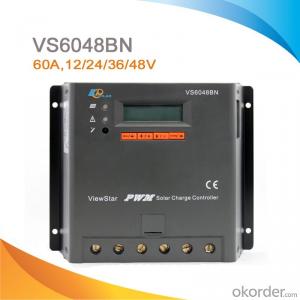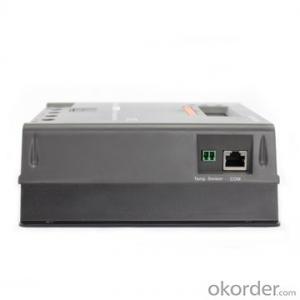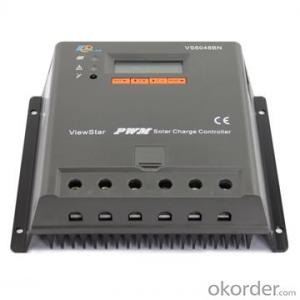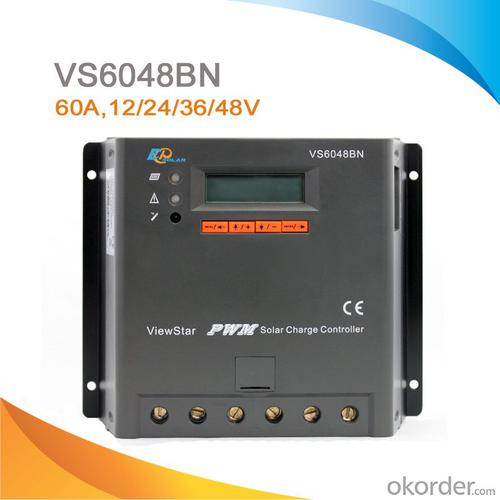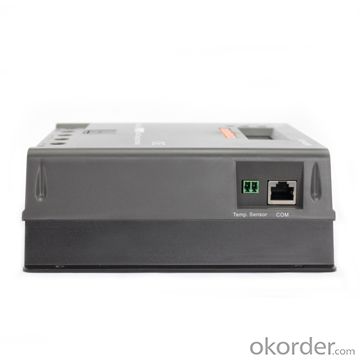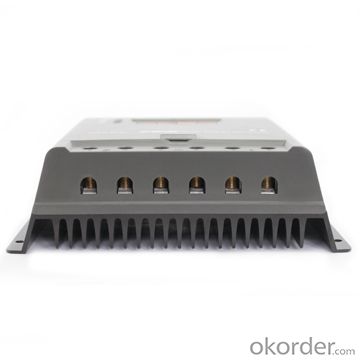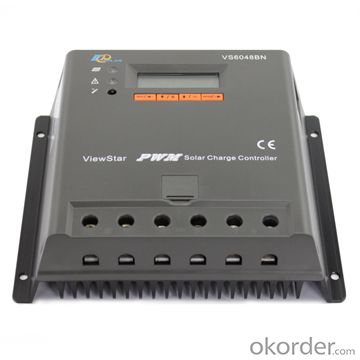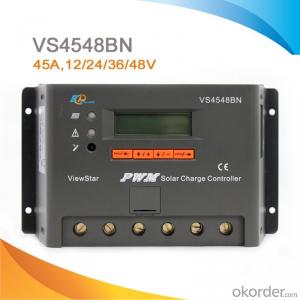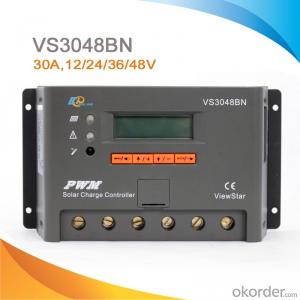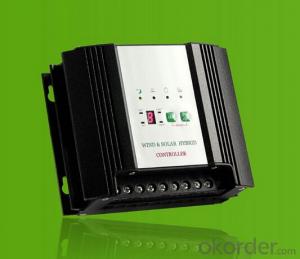Solar Controllers 10a LCD Display PWM Solar Charge Controller /Regulator 60A 12/24/36/48V, VS6048BN
- Loading Port:
- Tianjin
- Payment Terms:
- TT or LC
- Min Order Qty:
- -
- Supply Capability:
- 10000 pc/month
OKorder Service Pledge
OKorder Financial Service
You Might Also Like
Features:
·Excellent EMC design
·32 bit MCU with high speed
·High efficient Series PWM charging
·Four battery type options: Sealed, Gel, Flooded, and USER
·Intelligent lighting and timer control for solar lighting system
·12 bit A/D high-precision sampling to ensure accuracy
·Use MOSFET as electronic switch
·Full control parameters setting and modification, diversified load control mode
·Humanized design of browser interface, undertake every operating conveniently
·Temperature compensation
·Adopt graphics dot-matrix LCD screen and HMI (human-machine interface) with 4 buttons,integrated menu displaying and operation
·Energy statistics function
·RS485 ports with MODBUS communication protocol
·Optional PC monitoring software and remote meter for real-time monitoring and battery management parameter setting
·Field upgradable firmware
Electronic Protections:
·PV short circuit protection
·PV reverse polarity protection
·Battery overcharge protection
·Battery over discharge protection
·Battery reverse polarity protection
·Load overload protection
·Load short circuit protection
·Overheating protection
Specification:
Nominal system voltage | 12/24/36/48V auto work | |||
Rated battery current | 20A | 30A | 45A | 60A |
Rated load current | 20A | 30A | 45A | 60A |
Max. battery voltage | 64V | |||
Equalize charging voltage | Sealed: 14.6V, Flooded: 14.8V, User-defined: 9~17V | |||
Boost charging voltage | Gel: 14.2V, Sealed: 14.6V, Flooded: 14.8V, User-defined: 9~17V | |||
Float charging voltage | Gel /Sealed /Flooded: 13.8V, User-defined: 9~17V | |||
Low voltage reconnect voltage | Gel /Sealed /Flooded: 12.6V, User-defined: 9~17V | |||
Low voltage disconnect voltage | Gel /Sealed /Flooded: 11.1V, User-defined: 9~17V | |||
Self-consumption | ≤15mA(12V); ≤10mA(24V); ≤9mA(36V); ≤8mA(48V) | |||
Grounding | Common negative | |||
Temp. compensation | -3mV/°C/2V | |||
Relative humidity | 10%~90% Non-condensation | |||
Communication | RS485 / RJ45 interface | |||
LCD temperature | -20°C ~ +70°C | |||
Working temperature | -25°C ~ +55°C | |||
Humidity | ≤95% N.C. | |||
Enclosure | IP30 | |||
Overall dimension | 200x103x58mm | 201x109x59mm | 205x119x67mm | 205x174x64mm |
Terminals | 16mm2 | 35mm2 | 35mm2 | 35mm2 |
Net weight | 0.7kg | 0.9kg | 1.2kg | 1.5kg |
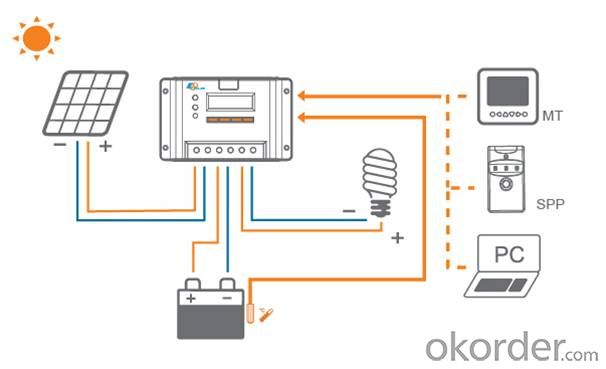
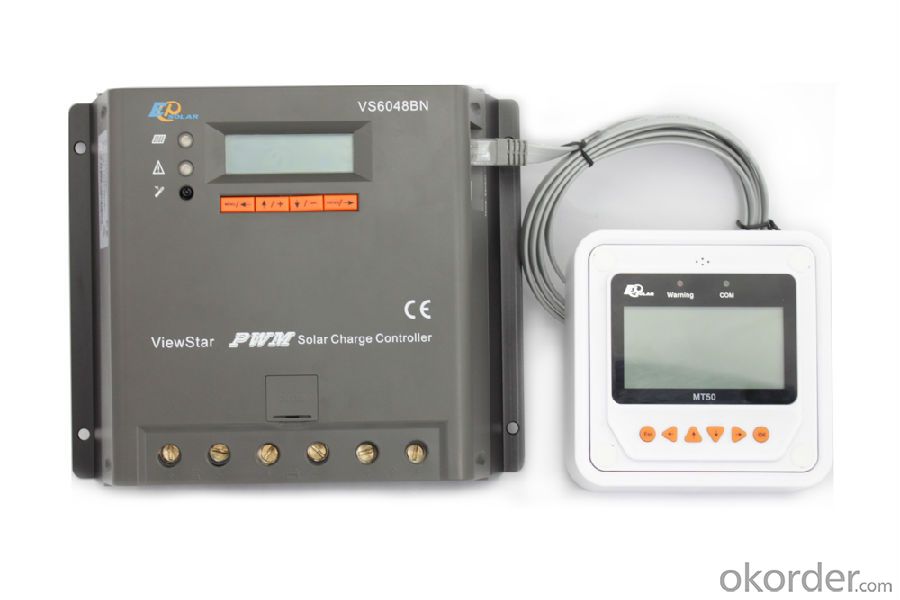

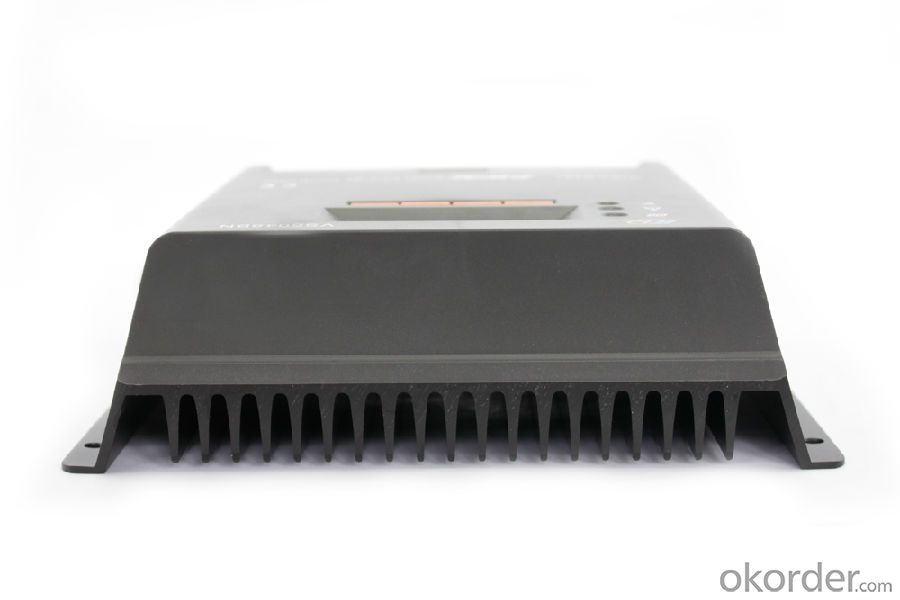
FAQ:
Q1. What is the voltage?
A1. Our 45/60A solar charge controller is 12/24/36/48V auto work.
Q2. What is the difference between MPPT&PWM?
A2. MPPT has higher efficiency, it can track the max power point and won't waste energy.
Q3. What is the efficiency of the MPPT controller?
A3. MPPT>99%, peak conversion efficiency>98%.
Q4. What is the waranty of product?
A4. 12 months.
- Q: Can a solar controller be used in a solar-powered electric wheelchair charging system?
- Yes, a solar controller can be used in a solar-powered electric wheelchair charging system. A solar controller helps regulate the power flow from the solar panels to the battery, ensuring efficient and safe charging. It can manage the charging process, prevent overcharging or undercharging, and maximize the battery lifespan. By using a solar controller in a solar-powered electric wheelchair charging system, the system can effectively harness solar energy and provide a reliable source of power for charging the wheelchair.
- Q: Can a solar controller be used with a solar-powered signage system?
- Yes, a solar controller can be used with a solar-powered signage system. A solar controller is responsible for regulating the charging and discharging of batteries in a solar-powered system. In the case of a solar-powered signage system, the solar controller will help optimize the energy generated by the solar panels and ensure that the batteries are charged efficiently. It will also protect the batteries from overcharging or discharging, extending their lifespan and maintaining the reliability of the signage system.
- Q: Can a solar controller be used with a solar-powered refrigerator?
- Yes, a solar controller can be used with a solar-powered refrigerator. A solar controller is designed to regulate the flow of electricity from the solar panel to the battery, ensuring optimal charging and preventing overcharging. It can effectively manage the power supply to a solar-powered refrigerator, ensuring efficient operation and protecting the battery from damage.
- Q: What is the role of a solar controller in preventing battery over-discharge?
- The role of a solar controller in preventing battery over-discharge is crucial in maintaining the health and longevity of the battery. A solar controller, also known as a charge controller, is an essential component in a solar power system. Its primary function is to regulate the charging process from the solar panels to the battery bank. However, it also plays a vital role in preventing battery over-discharge. When the solar panels generate electricity, the solar controller monitors the battery's state of charge (SOC) and prevents it from being excessively discharged. It does so by measuring the voltage level of the battery. Once the battery voltage reaches a specific threshold, indicating a low SOC, the solar controller automatically disconnects the load from the battery. This prevents any further discharge, protecting the battery from over-discharge, which can lead to permanent damage or reduced capacity. Additionally, many solar controllers have programmable settings that allow the user to set the voltage thresholds at which the load is disconnected and reconnected. This feature enables customization based on the specific battery type and user preferences. In summary, the role of a solar controller in preventing battery over-discharge is to monitor the battery's voltage level and disconnect the load when it reaches a predefined low threshold. By doing so, it safeguards the battery from excessive discharge, ensuring its longevity and optimal performance.
- Q: What is the role of a solar controller in preventing damage to the solar panels from power surges?
- The prevention of damage to solar panels from power surges is of utmost importance, and this is where the solar controller comes into play. Referred to as a charge controller as well, it acts as an intermediary between the solar panels and the battery or power grid. Its main objective is to ensure that the energy produced by the panels is stored or used efficiently and securely. One crucial function of the solar controller is safeguarding the solar panels from power surges. These surges occur when there is a sudden surge in voltage, which may be caused by lightning strikes, fluctuations in the power grid, or other external factors. These unforeseen events can have detrimental effects on the delicate electronic components of the solar panels, greatly reducing their lifespan or rendering them completely useless. To prevent damage from power surges, the solar controller effectively manages the flow of electricity from the panels to the battery or grid. It expertly regulates the voltage and current levels, ensuring they remain within safe parameters. When a power surge is detected, the controller acts as a protective barrier, effectively blocking the surge from reaching the vulnerable solar panels. Moreover, many solar controllers are equipped with built-in surge protection devices, including surge arresters or metal oxide varistors (MOVs). These devices are designed to absorb excessive voltage spikes and redirect them away from the panels, providing an extra layer of protection against potential damage. In summary, the role of the solar controller in preventing damage to solar panels from power surges is to maintain control over the flow of electricity and shield the panels from sudden increases in voltage. By acting as a protective barrier and incorporating surge protection devices, the controller ensures the long-lasting performance and optimal functionality of the solar panels, ultimately maximizing the efficiency and effectiveness of the entire solar power system.
- Q: How does temperature affect the charging process in a solar controller?
- Temperature can affect the charging process in a solar controller by influencing the efficiency and performance of the system. Higher temperatures can cause the solar panels to heat up, which reduces their efficiency and lowers the overall charging capacity. Conversely, lower temperatures can enhance the efficiency of the panels and improve charging. Additionally, extreme temperatures can also impact the battery's performance and lifespan, affecting the overall charging process in a solar controller.
- Q: How does a solar controller handle battery float charging?
- A solar controller handles battery float charging by continuously monitoring the battery voltage and adjusting the charging current accordingly. Once the battery reaches its maximum charge level, the solar controller automatically reduces the charging current to a lower level to maintain the battery's charge without overcharging it. This float charging mode helps prevent battery damage and prolong its lifespan.
- Q: Can a solar controller be used with solar-powered indoor office buildings?
- No, a solar controller is typically used in off-grid solar systems to regulate and control the flow of electricity from the solar panels to the batteries. In indoor office buildings, the electricity is usually sourced from the grid and supplemented by solar panels. Therefore, a solar controller is not necessary for solar-powered indoor office buildings.
- Q: How does a solar controller handle fluctuations in battery voltage?
- A solar controller handles fluctuations in battery voltage by regulating the flow of solar energy to the battery. It monitors the voltage level and adjusts the charging or discharging process accordingly, ensuring that the battery receives the appropriate amount of power and preventing damage from overcharging or deep discharging.
- Q: How does a solar controller handle fluctuations in ambient temperature?
- A solar controller handles fluctuations in ambient temperature by utilizing temperature compensation techniques. It monitors the temperature and adjusts the charging voltage accordingly to ensure optimal battery charging. This helps maintain the battery's lifespan and improves overall system performance.
Send your message to us
Solar Controllers 10a LCD Display PWM Solar Charge Controller /Regulator 60A 12/24/36/48V, VS6048BN
- Loading Port:
- Tianjin
- Payment Terms:
- TT or LC
- Min Order Qty:
- -
- Supply Capability:
- 10000 pc/month
OKorder Service Pledge
OKorder Financial Service
Similar products
Hot products
Hot Searches
Related keywords
